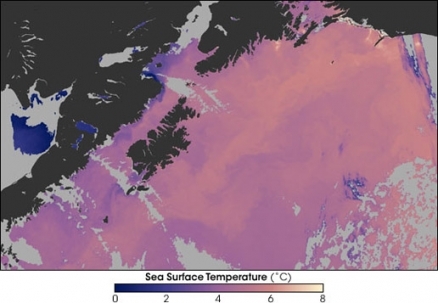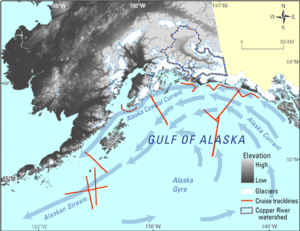Alaska Gyre
The Alaska Gyre is a system of wind-driven surface currents that rotate counter-clockwise in the Gulf of Alaska. More precisely, it is an oceanic subpolar cyclonic circulation system of the northeast Pacific Ocean associated with winds caused by a semi-permanent area of low atmospheric pressure near the Aleutian Islands known as the Aleutian Low.
The primary currents consist of a broad eastern boundary current flowing north, condensing into a narrow western boundary flow in the apex of the gyre and proceeding west–southwest along the Aleutian Peninsula as the Alaskan Stream.The Alaska Gyre imparts much of its angular momentum to the Alaska Current, which flows in a westward direction, slightly to the north of the gyre itself.
Contents
Currents Associated with the Alaska Gyre
The Alaska Gyre is fed by waters flowing east across the northern Pacific Ocean.This flow known as the West Wind Drift where it forms the southern part of the Alaska Gyre splits as it approahes the North American continent. The south flowing branch becomes the California Current and the north flowing branch becomes the Alaska Current.
The Alaska Current is the eastern and northern part of the Alaska Gyre. The current flows along the coastline of the southern part of the Alaskan Peninsula. This current is concentrated on the shelf region by the freshwater input from Alaskan rivers which enhances the pressure gradient across it. It is strongest in winter with current speeds around 0.3 meters/second and weakest in July and August, when prevailing winds tend to oppose its flow. The Alaska Current is fed by the anti-clockwise momentum of the Alaska Gyre.
Closer to coast runs the Alaska Coastal Current, also known by local names such as the Vancouver Island Coastal Current and the Haida Current.
Source: Washington State Department of Ecology.
The Alaska Current may or may not be distinguished from a western boundary current flowing along the Aleutian Islands that is known as the Alaskan Stream which is the western part of the Alaska Gyre. Both the Alaska Current and Stream have previously gone by the name of Aleutian Current. Whether or not the nomenclature makes a distinction, the Alaskan Stream and Current do have distinguishing characteristics. The Current is shallow and highly variable while the Stream is steadier and reaches to the ocean floor. The more barotropic nature of the latter is evidence that it is indeed a product of western boundary current dynamics while the former is in an eastern boundary regime.
Atmospheric-Ocean Interactions
A semi-permanent, subpolar area of low pressure known as the Aluetian Low is located in the Gulf of Alaska near the Aleutian Islands. It is a generating area for storms and migratory lows often reach maximum instensity in this area. It is most active during the late fall to late spring. During the summer, it is weaker, retreating towards the North Pole and becoming almost nonexistent. During this time, the North Pacific High pressure system dominates. As a result, the region is dominated by strong counter-clockwise (known as "cyclonic" in the northern hemisphere) winds during the winter which decline and become weak clockwise ("anti-cyclonic") wind patterns in the summer. Thus, the Aluetian Low has significant impact on winds and curents in the North Pacific, including the Alaska Gyre.
Marine Ecosystem
See main article: Gulf of Alaska large marine ecosystem
The climate of the North Pacific changes sharply decadally, as well as over centuries and millennia, in concert with climatic processes in other parts of the world, such as in the North Atlantic. This has an effect on plankton biomass production and plankton species composition. The Gulf of Alaska Large Marine Ecosystem is a Class I, highly productive (more than 300 grams of carbon per square meter per year) ecosystem. It presents a significant upwelling phenomenon linked to the presence of the counterclockwise Alaska Gyre of the Alaska Current National Oceanic and Atmospheric Administration, 2002).
The Large Marine Ecosystem’s cold, nutrient-rich waters support a diverse ecosystem. Large-scale atmospheric and oceanographic conditions affect the productivity of this Large Marine Ecosystem. There are differences in opinion as to the causes of the eastern bifurcation of the Subarctic Current into the Alaska Current, and the possible effects of these changes on biological production. Changes in zooplankton biomass have been observed in both the Gulf of Alaska Large Marine Ecosystem and the California Current Large Marine Ecosystem directly to the South. These biomass changes appear to be inversely related to each other (Brodeur et al., 1999). A well-documented climatic regime shift occurring in the late 1970s caused the Alaska Gyre to be centered more to the east (Lagerloef, 1995). Brodeur and his co-authors hypothesize changes in the future productivity of the salmon fishery as a consequence of long-term shifts in the plankton biomass in the last decades. More information is available on climate variability and climate change and its effect on the abundance and production of marine organisms.
Further Reading
- Anderson, P.J., and J.F. Piatt. 1999. Community reorganization in the Gulf of Alaska following ocean climate regime shift. Marine Ecology Progress Series, 189:117-123.
- Brodeur, R.D. and D.M. Ware. 1992. Long-term variability in zooplankton biomass in the subarctic Pacific Ocean. Fish. Oceanogr., 1: 32-38.
- Francis, R.C. 1993. Climate change and salmonid production in the North Pacific Ocean. In: Proceedings of the Ninth Annual Pacific Climate (PACLIM) Workshop, K.T. Redmond and V.L. Tharp, eds. Calif. Dep. Water Res. Techn. Rep. 34, pp. 33-43.
- Heim, P. K., II, M. A. Johnson, and J. J. O'Brien. 1992., The Influence of the Alaskan Gyre on the Coastal Circulation in the Gulf of Alaska, J. Geophys. Res. 97 (C11) 17,765–17,775, doi:10.1029/92JC01260.
- Lagerloef, G.S.E. 1995. Interdecadal variations in the Alaska Gyre. JPO, 25:2242–2258.
- NOAA (National Oceanic and Atmospheric Administration). 1988. A National Atlas: Health and Use of Coastal Waters, United States of America. Fishery Resource Assessment Programs and Large Marine Ecosystems, Folio Map No. 7. National Ocean Service, Office of Oceanography and Marine Assessment.
- Stabeno, P.J., N.A. Bond, A.J. Hermann, N.B. Kachel, C.W. Mordy, and J.E. Overland. 2004. Meteorology and oceanography of the northern Gulf of Alaska. Cont. Shelf Res., 24, 859-897.
- Steele, J. H., S.A. Thorpe and K.K. Turekian, 2010. Ocean Currents: A Derivative of the Encyclopedia of Ocean Sciences. Academic Press, New York. ISBN-10: 0080964869.
- Saundry, Peter. 2011. Seas of the World. In: Encyclopedia of Earth. Eds. Cutler J. Cleveland. Environmental Information Coalition, National Council for Science and the Environment, Washington, D.C.
- Thomson, R.E. 1972. On the Alaskan Stream. JPO, 2: 363–371.
- Tomczak, Matthias and J. Stuart Godfrey. 1994. Regional Oceanography: An Introduction. Pergamon Press, Oxford, UK.

